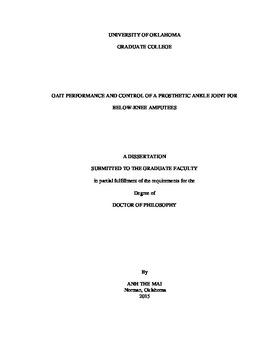| dc.description.abstract | Traumatic events such as accidents or vascular and circulatory disorders often lead to amputation of the lower limb below the knee joint. The surgery is followed by fitting of a prosthetic device and rehabilitation process to help the individual recover mobility. The recovered gait of the individual depends to a large extent on his/her health, the amputation technique, and the functional level of the prosthesis. Prior research in amputee gait has focused mostly on assessing gait symmetry, movement of the healthy joints, activities of the unaffected muscles, and the metabolic energy consumption in individuals who had undergone traditional amputation. Very little research has been carried out on the performance of individuals with non-traditional amputation procedures designed to maximize the ability of the residual limb to support body weight at the extremity and to maintain the ability of the affected muscles. Moreover, majority of the studies were limited to gait tests in laboratory environments which restricted the mobility of the individuals.
Current ankle/foot prostheses for people with below-knee amputation are primarily passive devices whose performance cannot be adapted or optimized to meet the requirements of different users. The adverse consequences of wearing poorly functioning prosthetic feet include asymmetric gait, increased metabolic consumption, limited blood flow, instability, and pain. Over the long term, the amputees, especially ones with diabetes, might have to undergo hip replacement procedure and use wheel-chair on a daily basis.
There exists a high and increasing demand for an advanced prosthetic foot that is comfortable and able to replicate the function of the biological foot. Some of the factors hindering the development and performance validation of such an actively controlled foot are the lack of complete understanding of the gait, the interaction between the residual limb and the controller, presence of human in the control loop, unknown interaction between the terrain and the foot, and stringent requirements on the mechanical power and rigidity of the foot.
This dissertation aims to address these shortcomings in a systematic fashion in order to develop an intelligent ankle/foot prosthesis system. The following are the key steps in the process adopted in this dissertation.
• First, a gait monitoring device and algorithms for gait analysis will be developed to study the gait of people with below-knee amputation in real time during work-related activities. Experimental protocols are then designed to collect gait data from individuals with below-knee amputation in order to understand the activity of the residual muscles and the ability of the prosthetic device to support body weight during gait.
• The dependence of the interfacial socket forces and electromyography signals from the muscles in the residual limb on the type of the gait and gait-related events will then be studied. The use of this dependence to recognize user gait and the corresponding ankle displacement pattern for the controlled prosthetic foot will be investigated.
• Finally, hierarchical learning-based control strategies will be developed to adaptively compensate for the unknown, changing ankle dynamics and drive the prosthetic ankle joint along the desired trajectories. It is anticipated that the learning capabilities of these control strategies will enable the prosthetic ankle joint to not only replicate the movement of the healthy ankle, but also improve the stability of the gait and optimize the performance.
The above approaches are demonstrated in this dissertation in two parts. The analysis of the gait of a group of otherwise healthy men with non-traditional amputation technique called transtibial osteomyoplastic amputation (TOA) is considered in the first part of the dissertation. The TOA procedure is prescribed for healthy, young individuals who desire a very active lifestyle. TOA offers stable bony residuum capable of bearing the weight of the individual and residual muscles that are active throughout the gait cycle. The gait study carried out in this dissertation is shown to confirm loading at the distal end-bearing area of the residual limb and active contraction of the residual muscles below the knee during gait of all participants. The interfacial forces in the socket and the activity of the residual muscles in subjects with TOA are shown to be related to and dependent on the type of gait, as well as the type of prosthetic feet used. In addition, the potential of residuum socket interface forces in recognition of the gait is also demonstrated.
Learning-based control of the prosthetic ankle joint is addressed in the second part of the dissertation. Two hierarchical learning-based control algorithms that take into account the ankle dynamics, foot-ground interaction, and the movement of upper body are considered. The first strategy uses an artificial neural network-based feedback linearization controller to learn the unknown and changing dynamics of the ankle joint and to track a desired ankle displacement profile. In the second strategy, a neural dynamic programming-based controller that can track an ankle displacement profile while optimizing a cost function based on the tracking error is considered. Actual gait data obtained from the subjects in the first part of this dissertation is used to study the effectiveness of the control strategy. For the first time, an adaptive controller has been demonstrated that can address changes in terrain and in user requirements to provide consistent and stable functioning of the prosthetic ankle. It is anticipated that the strategy developed in this dissertation will help build an intelligent prosthetic foot that can significantly improve the mobility and long-term health of people with amputation of the lower limb.
Keyword: Gait Analysis, Prosthetic Foot, Intelligent Control | en_US |
